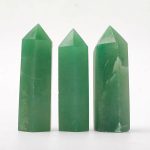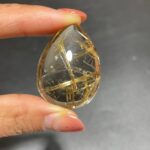Green jade, a captivating gemstone shrouded in mystery and lore, has captivated hearts and minds for centuries. Its alluring verdant hue, believed to symbolize harmony, growth, and prosperity, has made it a prized possession in cultures worldwide. This article delves into the enchanting world of green jade, exploring its captivating history, diverse applications, and the latest advancements that are unlocking its boundless potential.

Origins and History of Green Jade
Green jade is a type of nephrite, a metamorphic rock composed primarily of tremolite and actinolite minerals. It is formed through the alteration of ultrabasic rocks, such as peridotite or serpentinite, under intense pressure and temperature conditions. The distinctive green coloration is attributed to trace amounts of iron impurities.
The earliest known use of green jade dates back to Neolithic China, where it was fashioned into ornamental jewelry, tools, and ceremonial objects. It was particularly revered during the Shang Dynasty (1600-1046 BC), when jade carving flourished and became a symbol of status and power. Green jade remained a highly sought-after material throughout Chinese history, playing a significant role in religious rituals, artistic expression, and even currency.
Beyond China, green jade was also prized in other parts of Asia, including Korea, Japan, and Southeast Asia. It was introduced to Europe in the 16th century by Spanish conquistadors, who encountered it in Mesoamerica and South America. Today, green jade is sourced from various regions worldwide, including Myanmar (Burma), Canada, Russia, and New Zealand.
Physical Properties and Characteristics of Green Jade
Green jade is characterized by its unique physical properties:
-
Color: Green jade exhibits a wide range of green hues, from pale celadon to deep emerald green. The intensity and shade of green vary depending on the iron content and the presence of other minerals.
-
Hardness: With a Mohs hardness of 6.5 to 7, green jade is a relatively hard and durable material, making it suitable for carving, jewelry making, and other applications.
-
Specific Gravity: Green jade has a specific gravity of 2.9 to 3.1, which gives it a substantial weight and density.
-
Luster: Green jade displays a vitreous to greasy luster, meaning it has a glassy or oily appearance.
-
Translucency: The translucency of green jade varies, with some pieces being nearly transparent while others are more opaque.
Types of Green Jade
Green jade can be further classified into different types based on its texture, origin, and value:
Type A Jade: Natural and untreated jade, with no chemical treatments or enhancements.
Type B Jade: Jade that has been bleached to remove impurities and then impregnated with polymer resin to improve its appearance and durability.
Type C Jade: Jade that has been dyed to enhance its color and value.
Myanmar Jade (Imperial Jade): A highly prized variety of green jade renowned for its exceptional color, clarity, and translucency.
Canadian Jade: A type of green jade found in British Columbia, Canada, known for its vibrant green color and high durability.
New Zealand Pounamu: A type of green jade found in New Zealand, revered by the Maori people for its cultural and spiritual significance.
Traditional and Modern Applications of Green Jade
Green jade has a vast range of applications that have evolved over time:
Traditional Applications:
-
Jewelry: Green jade is widely used in jewelry making, creating necklaces, bracelets, earrings, and pendants. Its symbolic meaning of luck, prosperity, and good health makes it a popular choice.
-
Carvings: Artisans have crafted exquisite carvings out of green jade, depicting various subjects such as mythical creatures, animals, and religious figures.
-
Ceremonial Objects: Green jade was used to create ceremonial objects in ancient China, including ritual vessels, ceremonial swords, and royal seals.
-
Medicine: In traditional Chinese medicine, green jade is believed to have healing properties and is used to treat various ailments, including kidney and stomach problems.
Modern Applications:
-
Alternative Medicine: Green jade is still used in alternative medicine today, as it is believed to promote well-being, reduce stress, and enhance energy levels.
-
Jewelry and Accessories: Green jade remains a popular choice for jewelry and accessories, as it complements various styles and adds a touch of elegance and sophistication.
-
Interior Design: Green jade is used in interior design to create unique and eye-catching accents, such as tiles, countertops, and decorative objects.
-
Landscaping: Green jade pebbles and boulders are used in landscaping to add a touch of natural beauty and tranquility to gardens and outdoor spaces.
The Creative Potential of Green Jade
Beyond its traditional and modern applications, green jade holds immense potential for future innovations. The “jadefication” of various materials and technologies could lead to the creation of novel products and solutions:
-
Jade-Infused Textiles: Fabrics infused with green jade particles could provide antimicrobial, anti-odor, and cooling properties for clothing and home textiles.
-
Jade-Reinforced Composites: Green jade fibers could be incorporated into composite materials to enhance strength, durability, and thermal insulation.
-
Jade-Based Nanotechnology: Nanoparticles derived from green jade could have potential applications in medicine, electronics, and energy storage.
-
Jade-Inspired Biomaterials: The unique properties of green jade could inspire the development of advanced biomaterials for tissue engineering and regenerative medicine.
Tables for Understanding Green Jade
| Feature | Description |
|---|---|
| Color | Ranges from pale celadon to deep emerald green |
| Hardness | 6.5 to 7 on the Mohs scale |
| Specific Gravity | 2.9 to 3.1 |
| Luster | Vitreous to greasy |
| Type | Characteristics |
|---|---|
| Type A Jade | Natural and untreated |
| Type B Jade | Bleached and impregnated with polymer resin |
| Type C Jade | Dyed to enhance color |
| Myanmar Jade (Imperial Jade) | Exceptional color, clarity, and translucency |
| Traditional Applications | Modern Applications |
|---|---|
| Jewelry | Jewelry and Accessories |
| Carvings | Interior Design |
| Ceremonial Objects | Landscaping |
| Medicine | Alternative Medicine |
| Innovative Applications | Potential Benefits |
|---|---|
| Jade-Infused Textiles | Antimicrobial, anti-odor, and cooling properties |
| Jade-Reinforced Composites | Enhanced strength, durability, and thermal insulation |
| Jade-Based Nanotechnology | Applications in medicine, electronics, and energy storage |
| Jade-Inspired Biomaterials | Advanced biomaterials for tissue engineering and regenerative medicine |
Conclusion
Green jade, with its captivating allure and versatile applications, has captivated cultures for centuries. Its enduring charm, coupled with its potential for innovation, ensures that green jade will continue to inspire and enchant for years to come. As we delve deeper into its enigmatic qualities, we uncover new possibilities that push the boundaries of its traditional uses. From jade-infused textiles to jade-inspired biomaterials, the future of green jade is as boundless as its enchanting verdant hue.




























